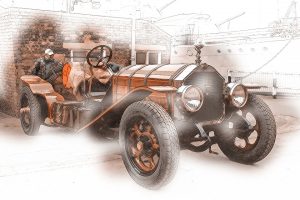
What’s an Automotive Journalist?
What’s an automotive journalist?
I guess to me, this seems obvious. After all, I’ve spent the last six years of my life studying reporting and communications in the classroom and on the street so that I could bring my passion to others who share it.
But, of course, it seems obvious to me because I’ve spent the last six years of my life studying reporting and communications, because I’ve spent nearly two decades watching automotive television programs, reading car enthusiast magazines and attending all manner of car shows, races, cruises, and concours. I’m certain there are things within the world of biochemistry or college football that others would be aghast to find out I didn’t know.
 We recently picked up and moved about a third of the way across the country, so I’ve been playing the getting-to-know-you game a lot, meaning I’ve been hearing what’s an automotive journalist more than usual. It’s often followed by a sort of sideways glance as the person registers all five foot, three inches of me with my Princess Lei double buns and Target striped pink flipflops and their expression changes to say maybe automotive has a meaning I’m not familiar with.
We recently picked up and moved about a third of the way across the country, so I’ve been playing the getting-to-know-you game a lot, meaning I’ve been hearing what’s an automotive journalist more than usual. It’s often followed by a sort of sideways glance as the person registers all five foot, three inches of me with my Princess Lei double buns and Target striped pink flipflops and their expression changes to say maybe automotive has a meaning I’m not familiar with.
Nope, automotive journalist says what it means.
And it doesn’t.
Because writing about cars isn’t just writing about cars. Not always. When it comes to being a reporter with a passion for the automobile, you have to be an expert on a whole lot more than just the automobile.
It didn’t always use to be that way. Depending on the era, automotive journalists were different things. They were chroniclers of history, they were consumer reporters, they were non-existent. The value of cars in the context of time and place has only been recognized as of late, the idea that this massive industry, with its fingers in the pot of business, economy, technology, design, and energy, may be something worth paying attention to.
And that’s part of being an automotive journalist.
Whether we’re writing about the cars of now or then or then-then, it is fundamental to understand the influence of the machine and the domino effect it had on the world. Like classic art, literature or music, classic cars tell a story and anticipate a future that a single element’s existence could alter completely. When you look at a car, be it now or be it then, you are looking at a whole world, wrapped in a shiny, beautiful package.

That’s some of being an automotive journalist.
But not all of it.
It’s good and fine to share the details of history. After all, some people show up for the facts and figures, the dates, the specs, the historical hard stone, unmoving and interesting all on its own. But many show up for something else entirely.
Because cars aren’t any regular invention. They’re not a toaster oven or a microwave, chock-full of historical significance, yes, but without soul or anthropomorphization. Cars have heart, they have memories, they have a history. Nearly every person you meet, whether dyed-in-the-wool enthusiast or license-less-city dweller, will have a car story to share. Hell, half my friends would probably recount tales of my classic Volvo station wagon and the months we spent chugging along during our summer camp years, hoping the old tank didn’t break down on the highway.
Being an automotive journalist is about the numbers, to an extent. It’s about delivering consumer information so the buyer can make smart decisions. It’s about sharing histories and facts and dates.
But it’s so much more than that. The numbers can be researched, the reviews can be Google-searched, the dates can be dug up on old library microfilm. No, the most important part of being a journalist isn’t the researching or even the reporting.
It’s the storytelling. 
Whether we write about hard industry news, the new Nissan Rogue’s first-quarter sales projections, or long-form articles on the history of hot rodding, we are sharing a human story. When we tell people about which cars are right for their families, we are reminding them about the cars of their own youth. When we shoot photos at the finish line or in the parking lot of the local diner built in the 1980s, we give a modern, humanist perspective to the future of the classic car hobby.
Cars aren’t just cars and automotive journalists aren’t just automotive journalists. We’re the people that provide the context for your car stories, the people that bring humanity into the mechanical beast, the crazy, impassioned auto enthusiasts who remind the world that these spectacular creations are not merely a way to get from Point A to Point B, but a vital chapter of human history, a witness to our memories, a player in each of our stories.
Philosophical and romantic? Undeniably. After all, I’ve written my fair share on market projections and industry trends.
But what would this role be without philosophy and romance?
The car world was forged in steel and grit from those with dreams, madness, and determination. There has never been an era of the automobile where it was nothing more than statistics, nothing more than numbers, nothing more than data. Why on earth should we start now?
What’s an automotive journalist?
Oh. I write about cars. ![]()

